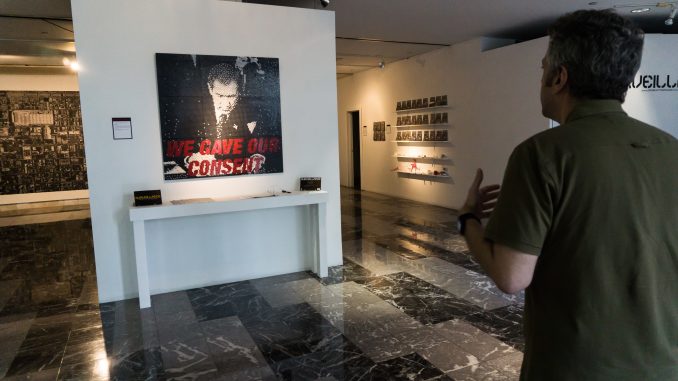
Four PlayStation controllers are mounted to a pedestal in Esther Klein Gallery in University City, but visitors aren’t allowed to play.
Artists Keith Hartwig and Daniel Newman, two former students, created the PlayStation controller arrangement as a part of their exhibit “Surveillance: An Exhibition of Work on the Observation, Recording, and Storage of Human Activity,” which is being shown until Sept. 30.
The pair expressed that the controllers were installed to reflect the aesthetic and technological connection between games and surveillance tools.
Hartwig, a 2011 architecture alumnus and an adjunct professor in Tyler, said consumer products, like personalized drones and GoPros, are an extension of the technology originally created for purposes of surveillance.
“A lot of the technology is being developed by the same researchers, it’s just being deployed into different areas,” Hartwig said.
Hartwig and Newman approached the exhibit from a shared interest in urban spaces.
“We both have a really strong interest in that intersection between mass media and the built environment,” said Newman, who took prerequisite classes at Temple for his master’s in architecture from the New School’s Parsons School of Design.

Multiple pieces in the exhibit specifically focus on the impact of surveillance on urban environments. The artists designed an aerial-view mural of Philadelphia from a drone photograph. They also created a time-lapse video entitled “Fatal Trajectories” to demonstrate how technology used to catch armed criminals can also record conversations across a city.
For every gunshot that occurred in Washington, D.C. during 2012, “Fatal Trajectories” displays a red dot on a map based on where ShotSpotter technology determined the gun was fired.
ShotSpotter, according to the “Surveillance” overview on Hartwig’s website, “is a proprietary technology and network of microphones affixed to infrastructure such as telephone poles and streetlamps.”
SST, Inc., the company that created ShotSpotter, claims on its website that “ShotSpotter sensors are specifically designed to be triggered by loud explosive or ‘impulsive’ sounds only.” Newman has a different view.
“These microphones are always on, and they’re always listening. They don’t just pick up the gunshots, they will pick up conversations, and this audio is stored and it’s recorded,” Newman said.
Another highlight of the exhibit is a set of four Lego re-creations of photographs marked with the text “WE GAVE OUR CONSENT.”
Each image represents a different reason the public submits to surveillance. One panel depicts George W. Bush signing the Patriot Act, a law that expanded the federal government’s powers of surveillance in response to the 9/11 terrorist attacks. According to the panel’s label, the image represents society’s submission to surveillance out of a desire for security.
The culminating piece of the exhibit, “Security Desk,” inverts the premise of the other pieces: visitors become the observers rather than the observed. Through the use of a computer program the artists designed for the exhibit, 20 seconds of live footage culled from unprotected security cameras around the globe is randomly displayed on several monitors.
Newman said that he and Hartwig screen the video feeds before adding new cameras to the program to ensure none of them display any “prurient or tawdry” material.
To the artists’ surprise, they found very few objectionable videos.
“The majority of what we found, and I know this might sound odd, was actually kind of heartwarming. It’s this overview of what people find important enough to put a camera on,” Newman said.
Newman has even noticed a difference in cultural values based on where people from a certain region aim their cameras.
“It seems in the United States people value their cars,” Newman said. “If you’re in the Mediterranean, it’s your patio that you have your camera on.”
Curator Angela McQuillan, a 2011 painting and drawing alumna, said that some visitors do not recognize the implications of “Security Desk.”
“A lot of people were like ‘Huh, that’s interesting,’” McQuillan said, “But don’t really understand the effects of that.”
“I’ve heard comments to the extent of, ‘Oh, do you think we’ll see someone get murdered?’ … and when they don’t, they walk away,” Newman said.
Newman attributes this nonchalant attitude toward surveillance to the proliferation of social media in daily life.
“People are so used to watching other people’s lives as entertainment that when they actually see it unfold unfiltered and unscripted, it’s like they’re watching TV,” Newman said.
Though he does not consider the exhibit an educational tool, he hopes it will serve as a reminder that technologies are constantly recording users’ behavior.
“When you use your credit card, when you speak in front of an Amazon Echo, when you use that ATM, at the end of the day, when all of that information gets aggregated together, that’s a complete picture of you and it’s out there somewhere,” he said.
Ian Walker can be reached at ian.walker@temple.edu.



Be the first to comment